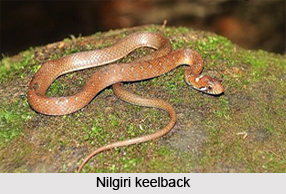 Nilgiri Keelback or Beddome`s Keelback is an Indian reptile that bears a scientific name "Amphiesma beddomei".
Nilgiri Keelback or Beddome`s Keelback is an Indian reptile that bears a scientific name "Amphiesma beddomei".
Concentration of Nilgiri Keelback
Nilgiri Keelback or Beddome`s Keelback is a species of snake found in the Western Ghats Mountain Range in India.
Naming of Nilgiri Keelback
The species Nilgiri Keelback or Beddome`s Keelback is named after Richard Henry Beddome, 1830–1911, British army officer and botanist.
Discovery of Nilgiri Keelback
Nilgiri Keelback or Beddome`s Keelback was first discovered near the Nilgiris Mountain Range but is now known more widely from the Western Ghats Mountain Range in India.
Feeding of Nilgiri Keelback
Nilgiri Keelback or Beddome`s Keelback is terrestrial and feeds on toads.
Size of Nilgiri Keelback
Nilgiri Keelback or Beddome`s Keelback has the moderate eye. Its diameter in the adult equalling its distance from the nostril; rostral just visible from above; suture between the internasals as long as that between the prefrontals; frontal larger than its distance from the end of the snout, a little shorter than the parietals; loreal as long as deep or deeper than long; one preocular; three (rarely two) postoculars; temporals 1+1 or 1+2; upper labials 8 or 9, third, fourth and fifth, or fourth, fifth, and sixth entering the eye; 5 lower labials in contact with the anterior chin shields, which are shorter than the posterior.
Scales of Nilgiri Keelback
Nilgiri Keelback has the scales in 19 rows. It rather strongly keeled, the outer however, perfectly smooth. Ventrals 131-150; anal divided and subcaudals 65-75.
Colour of Nilgiri Keelback
Nilgiri Keelback or Beddome`s Keelback is brown in colour. It has a series of yellow spots, each between two black spots or short transverse bands, along each side of the back; upper labials are yellowish with black sutures; a yellow, black-edged, oblique streak from the eye to the gape; a yellow band across the nape, behind the parietals, becoming indistinct with age; belly white, closely dotted with brown on the sides.
Length of Nilgiri Keelback
Nilgiri Keelback has the total length of 51-66 cm (20-26 in.), tail 13-19 cm (5-7.5 in).
Habitat of Nilgiri Keelback
Nilgiri Keelback or Beddome`s Keelback prefers moist deciduous forests and evergreen forests.
Behaviour of Nilgiri Keelback
Nilgiri Keelback or Beddome`s Keelback can be found actively hunting from dawn to dusk on stream banks or close to other bodies of water.











